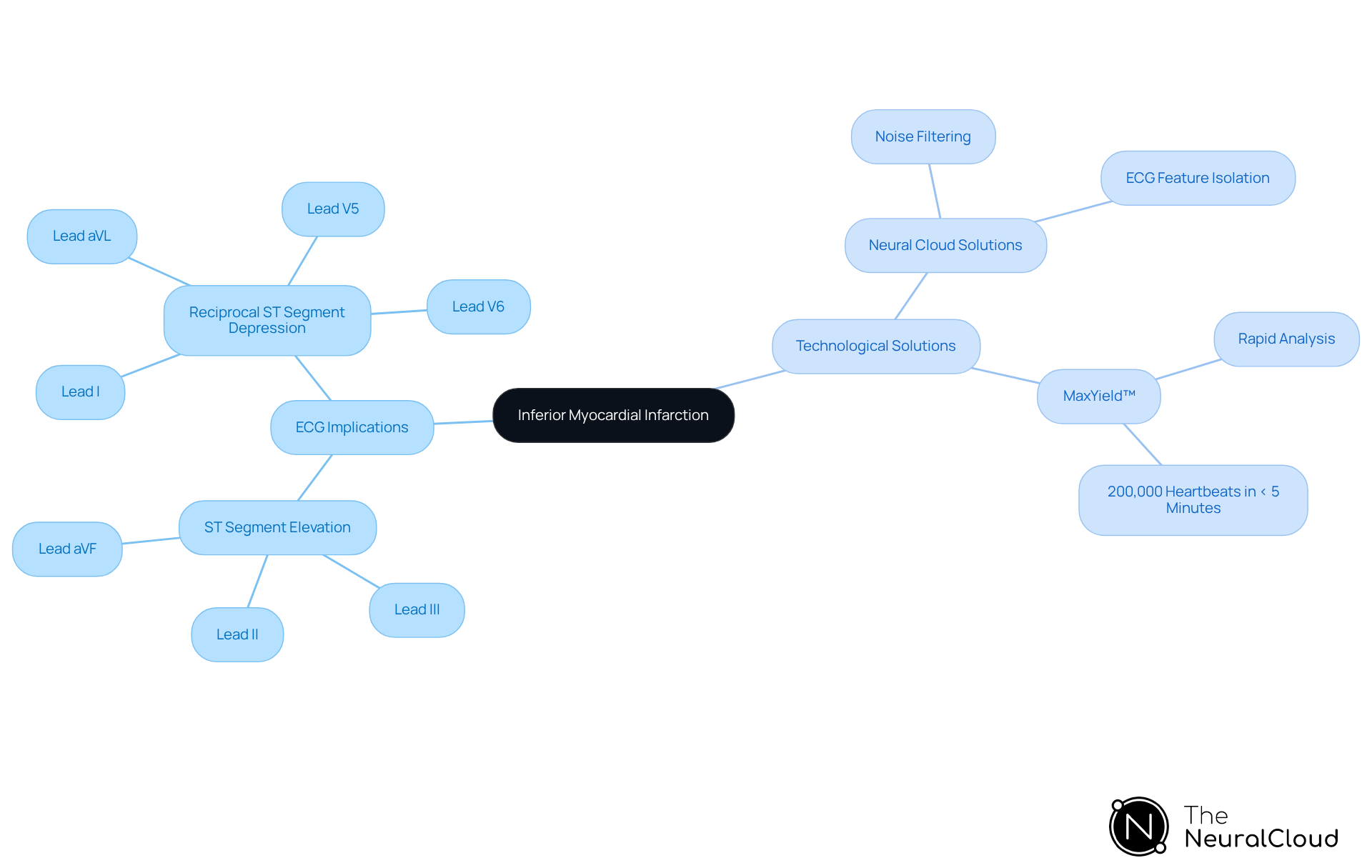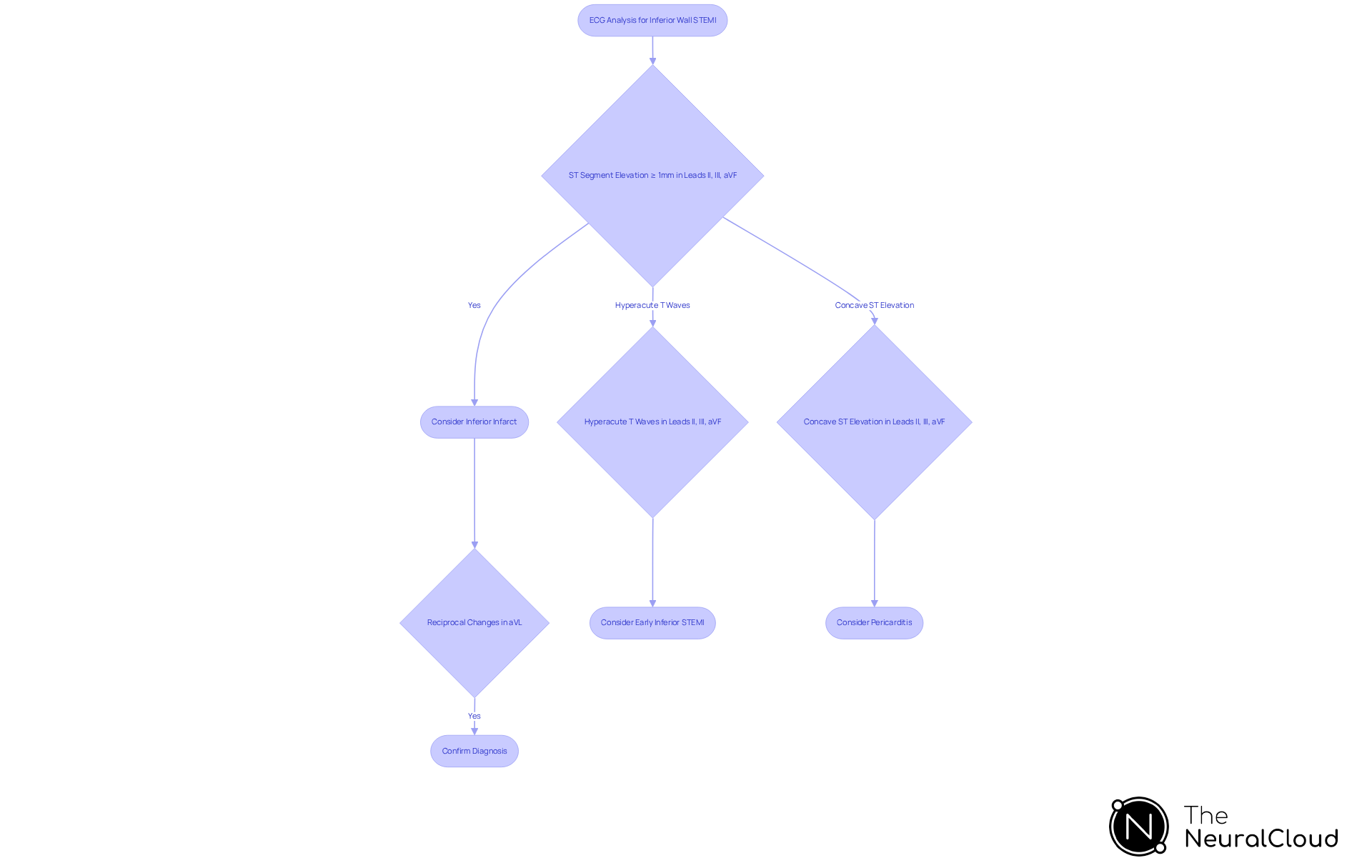Overview
Inferior infarct refers to a heart attack affecting the lower part of the heart, primarily caused by blockage in the right coronary artery. Key ECG indicators include ST segment elevation in leads II, III, and aVF. Recognizing these ECG patterns is crucial for timely intervention, as they guide clinical decisions and can significantly influence patient outcomes. Advanced analysis tools, such as Neural Cloud Solutions' MaxYield™ platform, enhance the accuracy and efficiency of ECG interpretation.
ECG analysis presents numerous challenges, including the complexity of interpreting various patterns and the need for swift decision-making in critical situations. The MaxYield™ platform addresses these challenges by providing features that streamline the analysis process. It leverages advanced algorithms to improve the accuracy of ECG readings, ensuring that healthcare professionals can make informed decisions quickly.
The advantages of the MaxYield™ platform are clear. By offering precise ECG interpretation, it reduces the risk of misdiagnosis and enhances patient care. Healthcare professionals benefit from improved workflow efficiency, allowing them to focus on patient outcomes rather than getting bogged down by complex data analysis. This ultimately leads to better overall care and quicker response times in emergency situations.
In conclusion, the integration of the MaxYield™ platform into clinical practice not only aids in the accurate interpretation of ECGs but also supports healthcare professionals in delivering timely and effective care to patients experiencing inferior infarcts.
Introduction
Understanding the intricacies of inferior myocardial infarction is essential for healthcare professionals, especially in interpreting ECG readings. This type of heart attack, primarily associated with the right coronary artery, displays specific patterns on an ECG that can indicate the severity and location of myocardial damage. However, the challenge lies in accurately identifying these patterns amidst potential noise and artifacts. Advanced technology can significantly enhance the interpretation of these critical signals, ensuring timely and effective patient care.
Define Inferior Myocardial Infarction and Its ECG Implications
The term [inferior infarct meaning](https://theneuralcloud.com/post/understand-inferior-infarct-diagnosis-and-key-insights) describes a heart attack that occurs in the lower part of the heart, primarily due to occlusion of the right coronary artery (RCA). The most prevalent ECG observations linked with IMI consist of ST segment elevation in channels II, III, and aVF, indicating harm to the inferior wall of the heart. Additionally, reciprocal ST segment depression may be observed in the lateral leads (I, aVL, V5, and V6). Understanding these patterns is vital for healthcare professionals, as they indicate the severity and location of myocardial damage, which relates to inferior infarct meaning and guides further management and intervention strategies. Accurate identification of these changes can significantly impact patient outcomes, making it a critical skill for clinicians.
The 'Neural Cloud Solutions' platform enhances this process by automating ECG analysis and providing advanced noise filtering capabilities. This platform swiftly isolates and labels essential ECG features, such as P-wave, QRS complex, and T-wave onsets and offsets, even in recordings with significant noise and artifacts. Such clarity enables a more precise interpretation of these vital signals, particularly important in the context of IMI, where understanding the inferior infarct meaning of ST segment changes can significantly impact patient outcomes.
MaxYield™ offers the ability to analyze 200,000 heartbeats in less than 5 minutes. This rapid analysis ensures that clinicians can make informed decisions quickly, ultimately and patient care. By supporting healthcare professionals in responding effectively to cardiac events, the platform enhances their ability to manage critical situations. The integration of this technology represents a significant advancement in ECG analysis, leading to better patient outcomes and streamlined clinical processes.

Analyze ECG Patterns in Inferior Wall ST Segment Elevation Myocardial Infarction
In cases of inferior infarct meaning, the ST segment rise in myocardial infarction (STEMI) typically exhibits a significant ST segment increase of 1 mm or more in leads II, III, and aVF on the ECG. Hyperacute T waves may precede these changes, indicating early ischemic events. Additionally, reciprocal ST segment depression in the lateral electrodes (I, aVL, V5, and V6) is a common finding. The presence of ST elevation in these leads signifies a considerable area of myocardial injury, often linked to extensive coronary artery disease. Recognizing these patterns is crucial for timely intervention, as they inform decisions regarding reperfusion therapy and other essential treatments.
Recent studies indicate that notable ST elevation in leads II, III, and aVF, combined with the early development of Q-waves, can confirm the inferior infarct meaning, particularly when reciprocal changes are observed in lead aVL. This highlights the importance of precise ECG interpretation in managing acute myocardial infarction, as prompt diagnosis significantly enhances patient outcomes. The Neural Cloud Solutions platform streamlines this process by automating ECG labeling and data extraction, allowing healthcare professionals to manage cases more efficiently without compromising quality.
This automation not only boosts accuracy but also lowers operational costs by reducing the time spent on manual data handling. The incidence of acute myocardial infarction (AMI) is nearly 3 million cases globally, underscoring the importance of identifying STEMI patterns. and restoration of blood flow to the heart are vital, as emphasized by Oren Mechanic, reinforcing the urgency of recognizing these ECG changes for prompt intervention.
Moreover, clinicians should note that concave ST elevation in leads II, III, and aVF may mimic pericarditis; however, localized ST elevation with reciprocal changes in aVL confirms the diagnosis of inferior infarct meaning. Case studies illustrate these concepts, such as instances where the inferior infarct meaning was mistaken for pericarditis, highlighting the necessity for meticulous ECG interpretation. By leveraging the advanced features of the system, healthcare professionals can address inefficiencies and physiological variability in ECG analysis, ultimately improving patient care.

Utilize Advanced ECG Analysis Tools for Enhanced Interpretation
ECG analysis presents several challenges, particularly in accurately interpreting complex data. Advanced tools like Neural Cloud Solutions' MaxYield™ platform leverage artificial intelligence and machine learning to enhance this interpretation. The platform rapidly labels P, QRS, and T-wave intervals, automating the detection of key features. This capability allows healthcare professionals to analyze over 200,000 heartbeats in under five minutes, significantly improving efficiency.
MaxYield™ employs advanced noise filtering and wave recognition techniques, which help minimize the impact of noise and signal artifacts that can obscure true ECG signals. This functionality ensures that clinicians have access to clearer data sets, enabling more accurate assessments. By streamlining workflows through automation, the platform allows healthcare professionals to concentrate on high-level decision-making rather than time-consuming manual tasks.
Integrating advanced ECG analysis into clinical workflows not only enhances diagnostic accuracy but also improves overall patient care. The actionable insights provided by the MaxYield™ platform empower clinicians to make informed decisions swiftly, ultimately benefiting patient outcomes. With these advancements, the platform represents a .

Conclusion
Understanding the implications of inferior infarct meaning is crucial for effective diagnosis and management of myocardial infarction. This article highlights the significance of recognizing specific ECG patterns associated with inferior wall heart attacks, particularly the ST segment elevations in leads II, III, and aVF. By grasping these vital signals, healthcare professionals can make informed decisions that directly impact patient outcomes.
Key insights discussed include the role of advanced technologies, such as the Neural Cloud Solutions platform, which enhances ECG analysis through automation and noise filtering. This innovation streamlines the interpretation process and equips clinicians with the tools necessary to respond swiftly to cardiac events. Furthermore, the importance of accurate ECG reading in distinguishing between inferior infarction and other conditions, such as pericarditis, underscores the need for meticulous analysis.
Ultimately, leveraging advanced ECG analysis tools is essential for improving diagnostic accuracy and patient care. As the incidence of acute myocardial infarction remains significant, the integration of technology into clinical practice can enhance decision-making processes and lead to better health outcomes. Emphasizing the importance of understanding inferior infarct meaning and its ECG implications empowers healthcare professionals to act decisively, ultimately benefiting those at risk of myocardial infarction.
Frequently Asked Questions
What is inferior myocardial infarction (IMI)?
Inferior myocardial infarction refers to a heart attack that occurs in the lower part of the heart, primarily due to the occlusion of the right coronary artery (RCA).
What are the main ECG observations associated with inferior myocardial infarction?
The main ECG observations linked with IMI include ST segment elevation in leads II, III, and aVF, indicating damage to the inferior wall of the heart, as well as reciprocal ST segment depression in the lateral leads (I, aVL, V5, and V6).
Why is it important for healthcare professionals to understand ECG patterns related to inferior myocardial infarction?
Understanding these ECG patterns is vital as they indicate the severity and location of myocardial damage, which relates to the inferior infarct meaning and guides further management and intervention strategies.
How does the 'Neural Cloud Solutions' platform assist in ECG analysis?
The 'Neural Cloud Solutions' platform automates ECG analysis and provides advanced noise filtering capabilities, allowing for swift isolation and labeling of essential ECG features even in recordings with significant noise and artifacts.
What is the analysis capability of the MaxYield™ platform?
MaxYield™ can analyze 200,000 heartbeats in less than 5 minutes, ensuring that clinicians can make informed decisions quickly, which ultimately improves workflow efficiency and patient care.
How does advanced ECG analysis technology impact patient outcomes?
The integration of advanced ECG analysis technology enhances healthcare professionals' ability to respond effectively to cardiac events, leading to better patient outcomes and streamlined clinical processes.






